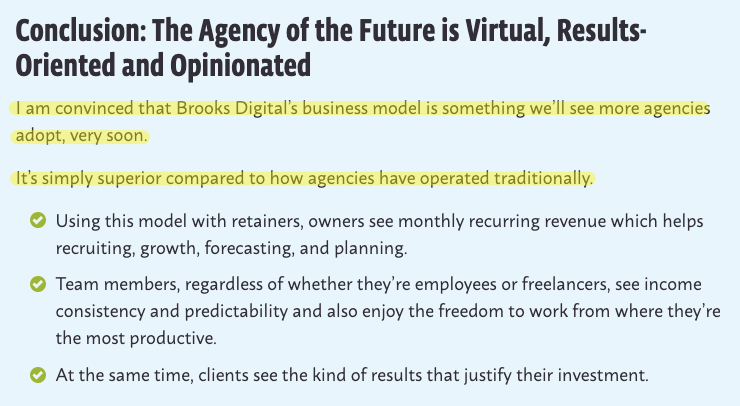Behind the Scenes of an Agency With No Employees
It’s no secret that Brooks Digital works a bit differently from other agencies.
How so? We use contractors in our staffing model instead of full-time employees (FTEs).
At the time of writing, we have a team of 11 contractors—developers, visual designers, project managers, UX strategists, and more—working on 6 concurrent website projects for our nonprofit clients.
This is something I have been transparent about in the past, from our About page to speaking at conferences about how to use contractors more effectively.
But, to this point, I haven’t really pushed this unique aspect of Brooks Digital. It’s for a few reasons, I think:
- I’ve preferred to write about the problems our clients are facing and provide immediate takeaways, rather than self-congratulatory or introspective posts.
- In the earlier days, I was still perfecting the fundamentals of this staffing model—and I wasn’t sure how permanent it would be.
- Using contractors has a certain hushed stigma about it, and frankly, despite having nothing to hide, I was afraid of how it would be received if I openly advertised it.
Despite working quite well for Brooks Digital, leveraging contractors for agency work is a very polarizing topic, even in the agency world.
On one hand, Brooks Digital has been called out as one of the next generation of digital agencies:
People such as my good friend Tyler Hakes who launched Optimist have taken a similar contract model to its logical conclusion and shown that it can scale. (Fun fact: I hired Tyler to do freelance content marketing and SEO in the early days of Brooks Digital before Optimist was a thing. I like to think my contractor model rubbed off on him somehow.)
On the other hand, I’ve had fellow agency owners insinuate that leveraging contractors is dishonest or somehow “lesser-than” because it’s not a traditional FTE team.
But the fact remains that the contractor model works for Brooks Digital—and a host of other digital agencies as well.
I think it’s important enough to address head-on so we can break the stigma and show that a digital agency with no FTEs aside from the founder can be done honestly, viably, and (I would argue) more sustainably than a traditional staffing model.
The origins of our contractor model
My journey to this contractor model was born out of necessity.
In the early days of Brooks Digital, I couldn’t afford to hire anyone full-time, so I contracted out various bits and pieces and managed everything myself. Despite having a few hiccups along the way, it worked. (I ate $20K on one of my first projects using contractors, but that client is still with us today.)
Later, once I could afford to hire, I brought on a FTE project manager because, well, that was what you did when you grew. What I discovered was it was difficult to construct a fully functioning team when I could only afford to hire 1-2 full-time people that needed to fill 4-5 part-time roles.

I ended up letting go of my project manager because although I could afford them, I really couldn’t considering the other roles I had to pick up in order to keep the business running.
The reality, I later saw, was that I needed someone who could juggle multiple specialist roles, and short of hiring a unicorn who was amazing at both (which requires either incredible luck or mega $$$) it wasn’t going to happen.
A value isn’t a value unless it costs you something
Those early days presented an interesting conundrum. Agencies are in the business of expertise, and it didn’t make sense to me to hire specialists and make them operate across multiple disciplines. Nor did it make sense to hire generalists and give them a bunch of specialized work.
Crucially, I was not willing to brute-force my way through this early phase at the expense of my family by working long hours and filling in the gaps until I could afford to hire a more specialized team. This was the traditional path I saw other agency owners take, and it didn’t align with my values.
I also wanted no part in the dreaded “agency crunch” where it was expected that teams ramp into 50-60+ hour weeks when projects were behind schedule or the agency sold more work than they had the capacity for. I saw that as a casualty at the intersection of the FTE staffing model and the unpredictable “big project” sales cycle that’s a reality for many agencies.
That culture clashed with my values of work/life balance, and I wanted to create something different at Brooks Digital.
So, after painful consideration, I turned back to contractors as my solution. I decided I would build a robust, specialized team of freelance experts able to scale according to client needs.
Each of these contractors had the right to choose their hours and schedule to fit their priorities and work from wherever they feel like. Plus, clients would get better results from a team of specialized contractors than a few generalists juggling multiple roles.
Especially 5 years ago, this was pretty new (or not talking about, at least) and I didn’t see many people doing it. I wasn’t sure if it was truly viable. It was risky to stray from the proven path of full-time staff.
But as they say, a value isn’t a value unless it costs you something.
Breaking the stigma

To my surprise, with a contractor model I found Brooks Digital was much more sustainable—both from a work/life perspective and a staying-in-business perspective—simply because I didn’t have to fill as many roles myself or carry the risk that accompanied a big payroll ticking down every two weeks.
Not only that, but clients were happy and sticking around. Most of our clients work with us for at least 3-5 years (our oldest client has been with us for almost 10 years) and as their needs change we are able to adapt our team accordingly.
I’m not saying that contractors are a silver bullet. At a certain scale, it makes a lot of sense to hire FTEs when you can keep them perpetually busy through the ups and downs. I also don’t think a full-time staff automatically means a workaholic culture.
But for Brooks Digital (and other agencies), contractors are an absolutely viable staffing model. It’s time to come out and say it.
Of course, every staffing model has its pros and cons. Let’s take a moment to discuss the common downsides and objections to working with contractors, and how this model deals with them.
The downsides to contracting
Let’s start with the 500-pound gorilla in the room: cheap outsourcing.
That, to me, is the major objection to contracting from both an ethical and value-for-the-money perspective. Someone pays an agency $150/hour, who promptly outsources the project to “their team” (which is really a dev shop in India or the Philippines) for $12/hour, delivering middling results and pocketing a tidy sum of cash.
This is the shady side of contracting that has, in part, created the stigmas we see today (and for good reason).

I don’t believe it’s ethical for an agency to charge premium/specialist rates and then farm out the work to the cheapest development shop they can find—all the while playing smoke and mirrors with their clients who could get basically the same result by hiring the development shop the agency is using. It’s a ripoff.
Cheap outsourcing, in my opinion, is fundamentally different from the contractor model used by Brooks Digital and other agencies. Namely, the differences in this new model are:
- Putting emphasis on leveraging a global network of talent to find the best available people—not the cheapest.
- Building a project team that does not exist outside the context of the agency. In other words, it’s not handing off a project to an outsourced company, it’s finding the individual contractors and hand-building the team based on the project.
- Organizing and providing contractors with their scope of work based on a carefully constructed blend of tools and processes owned by the agency to orchestrate work into the final end product.
As you can imagine, this approach takes a lot more time and careful attention. For Brooks Digital, the result is a flexible team tailored to each project and organized around our core tools and processes.
Another concern with the contractor model is reliability and teamwork. With a full-time employee, there is a certain level of undeniable commitment. With contractors, it’s easy to imagine a “mercenary gang” of hired guns each in it for themselves. Especially for big projects, it seems like a lot more risk—especially when the project can’t fail.
Ignoring for a moment that FTEs can (and will) put in their two weeks at any given moment, there are a couple of ways this gets handled through our vetting process.
How we vet our contractors for reliability and teamwork
You’ve probably heard the old adage, “hire slow, fire fast.” Well, for contractors, I like to think of it as, “hire fast, fire fast.”
The absolute best way to know if a person is a good fit for your team is to actually work with them. But, with full-time hires, you usually have to make a go/no-go decision before you ever get to work with them. And hiring and replacing FTEs is time-consuming and expensive.
That’s simply not the case with contractors, and we have leveraged that fact in our recruiting process. It has 3 basic steps:
- Application: we typically seed a description of the work we need to be done in places that produce high-quality contractors, such as niche Slack groups. In that description, we outline our expectations and also clear steps to apply for consideration. Those steps are specific enough that we are able to quickly weed out anyone who hasn’t fully read the description and is just copy/pasting the same response to all contract opportunities.
- Interview: promising candidates get a video interview via Zoom where we dig into their experience, gauge their interest/enthusiasm, and verify they are a good cultural fit with the rest of the contractors we work with.
- Pilot project: we send candidates who pass an interview a small project to not only test their ability to perform the work, but also the experience of working with them. We look at things such as 1) how quickly and reliably they respond to messages, 2) whether they have a good attitude and work well with others, and 3) if they keep their word and hit deadlines. Pilot projects also protect our team and clients from poor contractors who may go AWOL or produce subpar work, because they’re limited in scope and access. After the pilot project is complete, we review our experience working with them and determine if we’d like to send them future work.
Contractors who pass all 3 stages get expanded access to our systems and a spot in our contractor community (a nod to Tyler Hakes for this idea) which is a growing database of qualified freelancers we can use for projects. The very best ones get consistent, recurring work from us and first offers on new projects.

We also use some basic guidelines we’ve established over the years, which helps avoid common problems:
- We prioritize career contractors. These are the folks that are not interested in a full-time position and actually gravitate to long-term clients like us because the work is consistent. I find they work with us as long (or longer, in some cases) than FTE equivalents because they have more control of their environment as well as a variety of work through multiple clients. (We also work with people moonlighting outside their full-time job, but with clear expectations since there are more logistical and availability challenges.)
- We require fluent English. This unfortunately excludes some otherwise talented folks, but the reality is that building great websites hinges entirely on the precise communication of complex ideas. My rule of thumb is that if I feel like I need to speak more slowly or alter my vocabulary (read: simplify my communication), they’re not a good fit.
- We expect at least 3-4 hours of overlap with our standard business hours. This ensures that if the person is blocked or has a question, there is frequent opportunity to hop on a video call or have a quick back-and-forth on Slack.
- We standardize on key systems that keep everyone on the same page. When the team makeup is flexible, what must stay the same are the tools and systems used—namely when it comes to project management. With the input of the respective contract experts, we agree upon and standardize how we work together to ensure everyone is on the same page.
Okay, so what?
All of this only really matters as much as it offers a benefit to our clients beyond what an agency of full-time staff would offer. Here are the specific benefits I’ve found:
- The ability to build a custom team for every project leads to a better match between the specific challenges of the project and the needed expertise, which produces a better end product. A traditional FTE agency simply has fewer people to pull from at an equivalent size.
- Contractors have more freedom and flexibility to control their work environment and workload, which increases their satisfaction and improves their output. A Stanford study found that productivity drops sharply after 50 hours/week—a workweek that seems all-too-common in the traditional agency culture. I would suggest that more people working less individual hours on a project leads to a better outcome.
- It’s a remarkably resilient business model—which means we are more likely to be around long-term for our clients instead of going out of business.
Unexpected opportunities
I’d like to wrap up this deep dive with a story about one unexpected way this remote contract model has surprised me.
We have a Drupal Developer on our contract team named Syd. Syd is one of the most upbeat, enthusiastic guys you will ever meet (and a great developer to boot). He lives in Iran.
Before talking to Syd, I had no personal connection to what was happening in Iran. Through conversations, I learned firsthand how the US tariffs, which put the Iranian economy into a freefall, had affected him. I was shocked to learn how certain tools I took for granted, such as the ubiquitous GitHub used by over 40M developers, were simply inaccessible to him (at least without workarounds) because of his location.
The politics of the whole situation were fairly irrelevant to me, but Syd was very relevant. He was clearly an ideal addition to our team, and I saw how the opportunity to work with a company in the US was a very real lifeline to financial stability in an uncertain economic climate. He has turned out to be one of my favorite people to work with.
This, to me, is a perfect example of an inclusive business model and one of many reasons I truly believe our model is the next generation of digital agencies. It’s time we work to break the stigma and show that this model is viable, valuable, and the way of the future.






